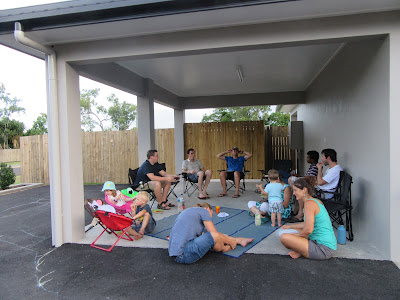 |
| On one of the days we loaded up the airplanes and all went to a remote airstrip to practice various maneuvers. |
The standardization course covers many topics that are impractical or non feasible to train in most other contexts, yet are often crucial skills for MAF pilots. As an example, if you are training on the Canadian prairies, you will likely be taught that if you have an engine failure after takeoff, you will pick a landing site straight ahead glide towards that field. But, what if you are flying out of an extremely remote jungle airstrip, where off the end of the strip is nothing but tall dense jungle? In this course we work through these situations, assessing and prioritizing risks, learning how to consider the aircraft capabilities, the precise handling that would be required, and the consequences both positive or negative that might result. Does that mean that a MAF pilot can always turn back to and land on the strip he just took off from? No, not necessarily. But he does have tools and training to look back on and say "I know I can do this, and this is why" or "That isn't an option, and I shouldn't spend precious time thinking about it."
 |
| VH-MZL is the Cessna 206 that I used for most of the course. A fantastic airplane that previously was part of the MAF PNG fleet. |
The second half of the course is designed to give exposure to "line flying," making decisions about who, what and where you can fly, loading airplanes safely and efficiently, and managing the variables that happen throughout a typical day flying. I think the instructors have a lot of fun with this one! For example, in one flight I was given a scenario in which I was to fly a parcel of vaccines to a remote hospital. As I arrived at the strip for landing the instructor said, "OK, there is a large herd of cattle sleeping on the runway. What are you going to do?" I decided to do a low pass to try to scare the "cows" off the runway, but apparently this didn't work - the instructor could still see the imaginary cows had not moved. So now what? Try to call someone on the ground to scare off the cattle? Perform an air drop (not an approved technique any more, so not this option!) or divert to another strip? In this case my decision was that a landing here was non-viable, so off to the next item on my agenda. And wouldn't you know it, just as I was thinking I had everything under control the engine fuel pump failed, and the switch for the electrical back up lit on fire!! (All simulated, of course. The safety of the flight is NEVER jeopardized.) Time for more decision making, and you better hope you can remember that emergency checklist.
 |
| Another Cessna 206, I flew VH-KBN to finish the course, and commemorated a successful final flight with this picture. |
While in Mareeba for Standardization, we lived in community with other MAF trainees and their families. This was great for Laura and Hannah who had people to spend the days with - others who were in the same stages of transition. We joined together to make pizzas one night and invited all of the families living in the complex (at one point each unit had a pizza in the oven!)
 |
| The Tilse Street Community on Pizza Night |
 |
| At the end of our time in Mareeba, we left most of our luggage (along with eight detailed pages of PNG customs forms) in the hangar ready to be sent up to PNG whenever a MAF plane is headed that way. |
At the end of March, we moved down to Cairns for a week-long Orientation to MAF-International. Our time in Mareeba meant that we already had relationships with most of the families who took the Orientation course with us. It meant that Hannah knew the kids as well as some of the ladies running the (excellent) childcare program. Although Cyclone Debbie was initially projected to make landfall near Cairns during our Orientation week, it detoured south and we experienced very hot weather (37C) instead.
 |
| Hannah enjoyed a week of going to "school" everyday. "Mom, seriously, that's enough pictures!!" |
Throughout the week, some of our workshops ran through policy and the various departments throughout the organization. Others dealt with the more practical - and serious - aspects of the role we are accepting: detailed workshops on safety and security protocol (such as how to exit a vehicle during a car-jacking), bribery, dealing with potential health issues, spiritual warfare and spiritual health.
 |
| Our fellow pre-field missionaries came from all over the world: The Netherlands, Switzerland, Australia, India, and Papua New Guinea. |
At the end of Orientation week, a number of the families moved to the programs where they will be working and others moved up to Mareeba to complete the standardization course that Tim just finished. Although we will be working for the same organization, we've formed friendships with people with whom we may not cross paths again. However, we look forward to reconnecting with some of these friends in PNG in the future.
And now... language training! Pray for us as we endeavor to become proficient in New Guinea Pidgin (Tok Pisin) before arriving in Papua New Guinea. During our remaining time in Cairns, we are working with a tutor from PNG. When we return to Canada for the birth of Baby Neufeld, we'll continue with book work - unless we can find some retired missionaries in our area who want to revive their Tok Pisin skills!